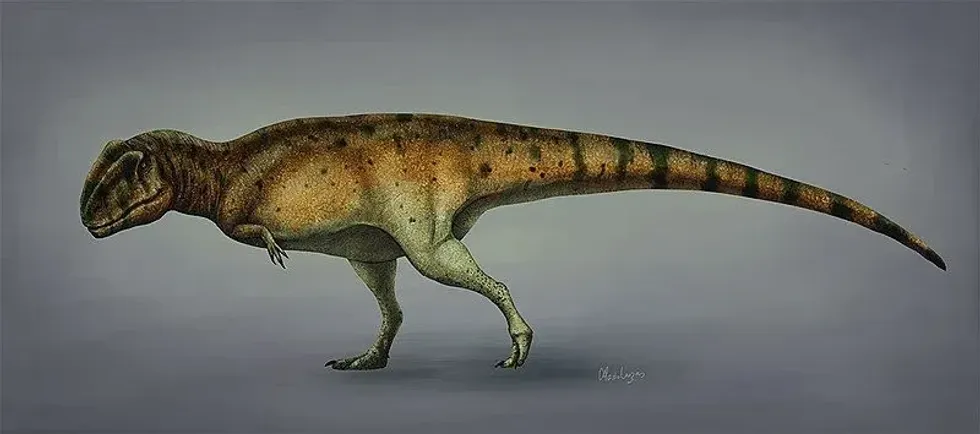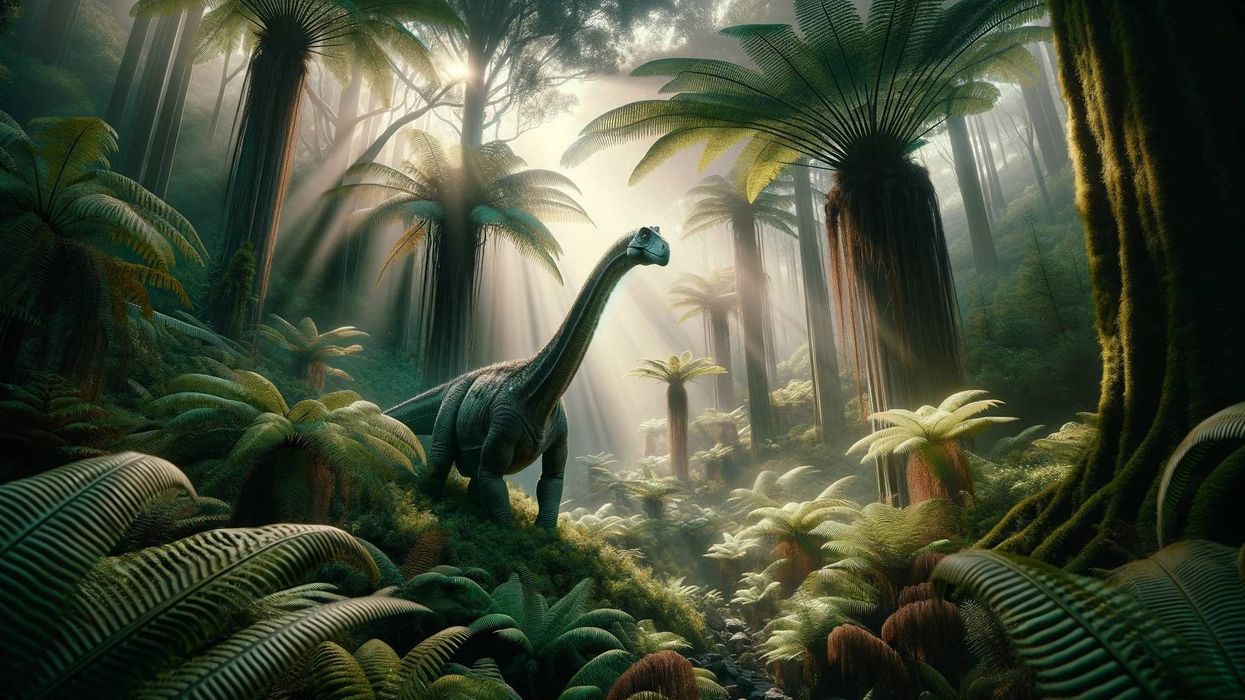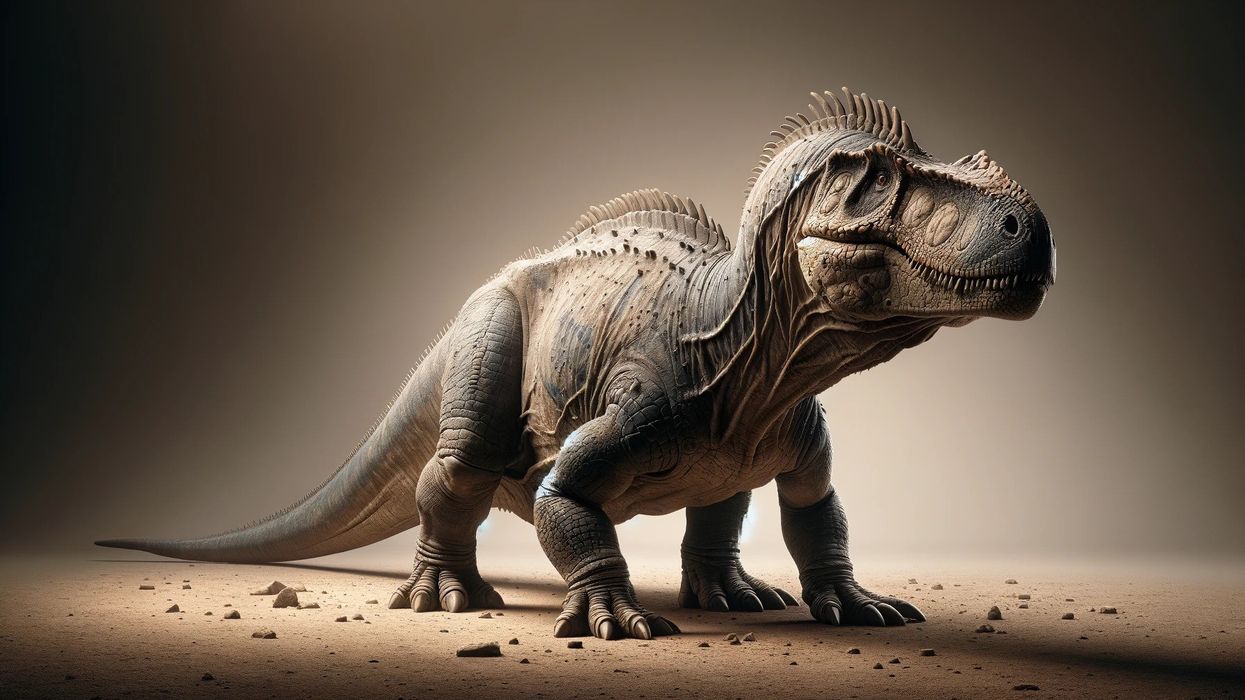Sauroniops is a genus of carnivorous primitive theropod dinosaur of the family Carcharodontosauridae. This dinosaur is from the Cenomanian stage of the Late Cretaceous period of Morocco (95 million years ago).
A dinosaur skull bone was given to the Italian Museo Paleontologist di Montevarchi by a collector in the early 21st-century. However, this collector got this specimen from a Moroccan fossil dealer, who had purchased the skeletal remain from local fossil hunters close to Taouz.
So, the exact origin of this specimen is uncertain. Later, research indicated that these remains were of new species in 2012, recorded and described by Andrea Cau, Fabio Marco Dalla Vecchia, and Matteo Fabbri.
This new species was officially named, in the same year, by these authors as Sauroniops pachytholus.
Sauroniops' intended meaning was 'eye of Sauron', referring to the character in J. R. R. Tolkien's 'Lord Of The Rings', a fantasy novel. In the novel, Sauron was limited to a single eye, and Sauriniops was also described by the single bone above their eye socket.
The classical Greek term 'ops', meaning 'eye', was combined with the name. Pachytholus has two Greek terms, pachys means 'thick', and tholos means 'round building conical roof', referring to the thick skull roof.
If these facts were interesting, then do read more about Xenotarsosaurus and Prosaurolophus on Kidadl.
Sauroniops Interesting Facts
How do you pronounce 'Sauroniops'?
The pronunciation of Sauroniops is 'Sow-ron-e-ops.'
What type of dinosaur was a Sauroniops?
Sauroniops named after the lord of the rings character is a Theropod group within the family Carcharodontosauridae. The sauroniops skeletal remains were described by Andrea Cau, Fabio Marco Dalla Vecchia, and Matteo Fabbri.
The holotype of this predator is named MPM 2594 and grew up to 40 ft (12 m). Sauroniops fossils that were found were bone skull parts above their massive eye socket.
Recent research in 2020 suggested this genus is a junior synonym of Carcharodontosaurus saharicus. This new species of Sauroniops had knobs and bumps on their massive head, which might have been used during head-butting and can be differentiated from their relatives using this feature.
This Carcharodontosaurid species might have been involved in head-butting to fight for their territories or mates. Despite the long, bladelike teeth and predatory behavior this dinosaur might have faced competition from other giant predatory relatives.
In which geological period did the Sauroniops roam the earth?
This Carcharodontosaurus dinosaur existed in the Cenomanian stage of the Late Cretaceous Period of Morocco around 95 million years ago.
When did the Sauroniops become extinct?
Sauroniops pachytholus became extinct likely around the mass extinction period of the Cretaceous-Paleogene age around 66 million years ago.
Where did a Sauroniops live?
Sauroniops pachytholus lived in Morocco in North Africa.
What was a Sauroniops' habitat?
These predator Sauroniops (Eye of Sauron) likely lived in terrestrial habitats in North Africa.
Who did a Sauroniops live with?
Like all the other dinosaurs these predator Sauroniops (Eye of Sauron) likely lived in groups.
How long did a Sauroniops live?
The maximum or the average lifespan of this giant African dinosaur is not yet known.
How did they reproduce?
The reproduction of Sauroniops (Andrea Cau, Marco Dalla Vecchia, and Matteo Fabbri) was oviparous. However, there is no data on their breeding and incubation.
Sauroniops Fun Facts
What did a Sauroniops look like?
 We've been unable to source an image of a Sauroniops and have used an image of a Giganotosaurus instead. If you are able to provide us with a royalty-free image of a Sauroniops, we would be happy to credit you. Please contact us at hello@kidadl.com.
We've been unable to source an image of a Sauroniops and have used an image of a Giganotosaurus instead. If you are able to provide us with a royalty-free image of a Sauroniops, we would be happy to credit you. Please contact us at hello@kidadl.com. Sauroniops (Eye of Sauron) dinosaurs, named after the 'Lord Of The Rings' character, are big bipedal predators. With the fossil evidence limited to only their upper-skull bone, only an outline of how Sauriniops really looked like could be drawn.
These species were likely as big as the other relatives of the same family.
There were conclusions made based on this small skull fragment that goes on top of their massive eye socket. They had a large head with knobs and bumps on this massive head, probably used for head-butting.
Their long, blade-like teeth allowed them to pierce the flesh of their prey. Their frontal bone and nasal bone were connected and the frontal bone was 40% the length of the nasal bone.
In the left front corner of the frontal bone, there is a thick vaulted area. A trapezoid facet on the frontal of the front upper rim contacts the prefrontal, which is separated by a vertical ridge from the lacrimal bone's facet and is not a part of the eye socket's upper rim.
They have a D-shaped lacrimal contact area that is very large and almost four times the height of the postorbital bone's facet.
There is an elevated rim inside the rear frontal, which is connected by saddle-shaped depression to the front vaulted area and more towards the skull's front midline, continuing into series of rugosities. They have a thick skull roof, a feature common in Abelisauridae.
How many bones did a Sauroniops have?
The exact number of bones in the skeleton of these flesh-eaters is not yet known.
How did they communicate?
Sauroniops (Eye of Sauron) probably communicated through body language, calls, and songs like all other dinosaur species.
How big was a Sauroniops?
Sauroniops' size was 40 ft (12 m) in length and their height was 9.8 ft (3.2 m). Their head was large measuring up to 5 ft (1.5 m) long. The frontal length is 7.32 in (186 mm).
How fast could a Sauroniops move?
This bipedal theropod predator might have been fast like relatives of the Carcharodontosauridae family.
How much did a Sauroniops weigh?
Sauroniops' weight range was about 4.9 short tons (4.5 metric tonnes).
What were the male and female names of the species?
There are no specific names given to female and male dinosaurs of this bipedal species yet.
What would you call a baby Sauroniops?
There is no specific name given to baby Sauroniops.
What did they eat?
These predatory species were carnivores probably feeding on smaller dinosaurs. They could easily pierce into flesh using their enormous teeth.
How aggressive were they?
These animals would have been pretty aggressive.
Did you know...
All the related species in the family Carcharodontosauridae measure in between 20-46 ft (6-14 m).
Sauroniops vs Carnotaurus: Carnotaurus is also a bipedal dinosaur, measuring almost half the length of Sauriniops, at around 24.6-29.5 ft (7.5-9 m).
Sauroniops vs Acrocanthosaurus: unlike Sauriniops, Acrocanthosaurus are from the early Albian stages of the early Cretaceous period.
Sauroniops vs Tyrannotitan: these related species of the same family as Sauriniops are from the Early Cretaceous period measuring about the same length as Sauriniops. Tyrannotitan is the oldest known Carcharodontosaurid, geologically with primitive Acrocanthosaurus.
Sauroniops vs T-rex: Tyrannosaurus rex, of the family Tyrannosauridae, was almost double the weight of these Sauroniop dinosaurs. T. rex species is also quite common among the general public.
It has been suggested that Carcharodontosaurids were even more closely related to abelisaurids than allosaurids are! This is because these two clades share similar cranial features but these features have been apparently derived from the two clades' parallel evolution.
Many studies on Carcharodontosaurid found in Argentina indicate that these dinosaurs were slow-growing almost taking 30-40 years to reach sexual maturity. The maximum age recorded or studied at the time of their death was 50 years, which makes these species the oldest non-avian theropod.
Theropoda consists of two Greek elements is a combination of 'wild beast' and 'foot.' Theropods were originally carnivores, however, they became insectivores, piscivores, omnivores, and herbivores. The early and most basal dinosaurs of Theropoda were the carnivorous Eodromaeus and Herrerasaurids.
What area did the Sauroniops live in?
This giant dinosaur might have occupied the Kem Kem Group in the Cenomanian stage in present-day North Africa.
How did the Sauroniops get its name?
Sauroniops' intended meaning was 'eye of Sauron,' like the character, a powerful entity in J. R. R. Tolkien's 'Lord of the Rings'. In the novel, Sauron was limited to a single eye, and Sauriniops was also described by the single bone above their eye socket. The classical Greek term 'ops,' meaning 'eye,' was combined with the name.
Here at Kidadl, we have carefully created lots of interesting family-friendly dinosaur facts for everyone to discover! For more relatable content, check out these Metriorhynchus facts and Chungkingosaurus facts for kids.
You can even occupy yourself at home by coloring in one of our free printable Sauroniops coloring pages.
*We've been unable to source an image of a Sauroniops and have used an image of a Mapusaurus instead. If you are able to provide us with a royalty-free image of a Sauroniops, we would be happy to credit you. Please contact us at hello@kidadl.com.









